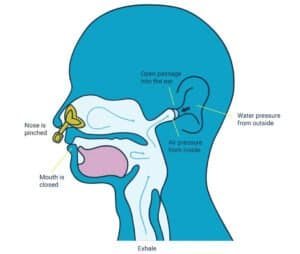
A Simple Guide to Freediving Equalization: Valsalva and Frenzel Methods

Introduction
Freediving is an exhilarating experience that allows you to explore the underwater world on a single breath. However, one of the most common challenges that new freedivers face is equalising ear pressure as they descend. Failure to equalise can result in ear pain and even damage to the eardrum. In this article, we’ll explore the concept of freediving equalization and focus on two primary methods: Valsalva equalization and Frenzel equalization.
Why is Equalisation Important?
When you dive underwater, the water pressure increases rapidly, especially in the first few meters. This increased pressure squeezes the air spaces in your body, including those in your sinuses and ears, causing discomfort or pain. Equalisation is the process of balancing this pressure by adding air back into these spaces. Successful equalisation feels like a small ‘pop’ inside your ear, relieving the pressure.
Valsalva Method

How it Works
The Valsalva method is straightforward: you pinch your nose closed and use your abdominal muscles to blow air into your nose. This action pushes air through your Eustachian tubes and into your middle ear, returning your eardrums to their normal position.
Why it’s Limited for Freediving
While the Valsalva method is easy to learn and commonly used by scuba divers and snorkelers, it’s not ideal for freediving equalization. This is because the technique relies on your breathing muscles to push air from your lungs. In freediving, your lungs compress as you go deeper, making it harder for these muscles to work effectively. Moreover, the forcefulness of Valsalva equalization can put you at risk of injury, especially at greater depths. The maximum average depth people can reach using Valsalva is around 10-15 meters.
Frenzel Method: The Preferred Technique for Freediving Equalization

How it Works
The key difference between Frenzel equalization and Valsalva equalization is that you use the air inside your mouth to equalize. The Frenzel method involves more muscle awareness and control. You pinch your nose, place your tongue in a certain position to make the “T” or “K” sound, close your vocal folds, and lift your larynx by moving your tongue. This action pushes air out of your mouth and into your nose, without involving your abdominal muscles.
Anatomy Involved
- Nasopharynx: The upper part of your throat connected to your nasal cavity.
- Soft Palate: Directs the flow of air in and out of your lungs.
- Vocal Folds/Glottis: A group of muscles that separate your mouth from your lungs.
- Larynx: Tube above the trachea controlling the flow of air.
- Eustachian Tube: Canal connecting your middle ear to your throat.
Why it’s Effective for Freediving
Frenzel equalization is preferred because it uses smaller, non-breathing muscle groups, making it more controlled and relaxed. This technique can take you to depths of 30-40m and even beyond with proper training. It’s perfect for freediving because it doesn’t require breathing muscles to push air, making it more efficient and safer for deeper dives.
Advanced Equalization Techniques
Hands-Free Equalization
This technique allows you to equalize by manipulating your Eustachian tubes through muscle control, without the need to pinch your nose. It’s a challenging skill to master but offers a unique way to manage ear pressure.
Mouthfill Equalization
Mouthfill equalization is an advanced technique where you fill your mouth with air at the surface and use this air to equalize as you descend.
Reverse Packing
This involves drawing air back from your lungs into your mouth, which is then used for equalization.
Learning These Freediving Equalization Techniques
Equalisation is a crucial skill for any freediver. While the Valsalva method is suitable for beginners, the Frenzel technique offers greater depth and flexibility. Understanding the anatomy and mechanics behind these methods can help you choose the best technique for your freediving adventures. However, it’s always best to book a course and learn these methods directly from a certified freediving instructor to ensure you’re practising them safely and effectively.
Ready to Learn the Art of Freediving Equalization?
If you’re interested in understanding the essential skill of equalization in freediving, look no further. Blue Freedom Apnea offers courses tailored for all levels, from beginners to advanced divers.
Our professional freediving instructors will guide you through the basics of Valsalva equalization and Frenzel equalization. For more advanced divers, we also offer in-depth training in specialized techniques.
With our expertise, you can be confident that you’re learning from the best in the field. Don’t miss out on the chance to learn from experts and improve your freediving equalization.
👉 Click here to enroll in Blue Freedom Apnea and start your journey in equalization today!
Share Now:
Recent Posts:


Freediving in Panglao: A World of Underwater Wonders


